CO2 mine gas - site investigation and risk assessment: best practice
Report collating current practice in local authorities and provide a summary assessment of options to deliver a standardised ‘good practice’ approach to risk assessment, reporting, mitigation and verification of mitigation measures for mine gas.
This document is part of a collection
3. Initial Stakeholder Engagement
Identification of stakeholders
3.1 The key stakeholders for this project were identified by BSD to be EHO/ CLO, Planning and Building Standards staff in the 23 LAs affected by coal mining issues.
3.2 Contacts for the stakeholder engagement were identified based on the engagement previously undertaken as part of the 2019 research project, those supplied by SG or those already known to RSK.
Initial stakeholder engagement methodology
3.3 The first stage of the stakeholder engagement involved the development of an online survey to seek views from the stakeholders on a range of issues to the aims and objectives of the project. The survey questions are shown in Annex A and the survey was generated in SurveyMonkey. The questions covered details about the respondent, questions specific to the planning and building standards approach to mine gas issues, and about participation in more detailed stakeholder engagement.
3.4 A total of 130 requests were sent by email to LA contacts on 11 December 2020 in all 23 relevant LAs. Of these, thirty-five requests were sent to Building Standards officers, 44 to EHO/ CLOs and 51 to Planning officers. As such for some LAs, multiple contacts within a department were sent a request to complete the survey. The covering email recommended that recipients co-ordinate with colleagues in their department to complete a single survey response, where applicable. Recipients were advised the survey findings would remain confidential and would only be used as a whole dataset, without publishing individual responses.
3.5 The online survey deadline was extended at the start of January 2021 with a reminder sent by email to all those who had not completed the online survey on
7 January. The survey was closed at 17:00 on Tuesday 12 January 2021.
Detailed survey findings
3.6 The survey findings are presented factually in the remainder of this section by topic area, identifying which question has been used in the data analysis. Note Questions 4 to 7 related to contact details to support the detailed consultation phase so the responses for these are not presented. Question 26 was a yes/no response in relation to examples of good practice, which were discussed further in the detailed engagement if a respondent answered yes.
Response rates [Q1 to Q3]
3.7 One or more responses were received from 21 of the 23 LAs (91%), with two LAs not responding. West Dunbartonshire Council answered that they did not respond to the survey as they were not sure if it was appropriate to do so given that mine gas is not of particular relevance in the LA area. They did comment that they do encounter many of the issues being considered in relation to ground gas risks relating to non-mining sources. The remaining outstanding authority, Clackmannanshire Council, was followed up on but no response was forthcoming.
3.8 A total of 46 responses were received out of a maximum of 69 (i.e. three departmental responses per LA), equivalent to a 67% response rate overall. Two officers from the same planning department at one LA responded to the survey. To avoid data bias, the first survey response received was included and the second survey response excluded. It is not considered the exclusion of this single duplicate response will alter the overall findings of the survey.
3.9 A total of 45 responses were therefore taken forward to the data analysis.
3.10 A summary of the responses received by respondent's role is presented in Table 3-1. Eight respondents identified themselves with a different officer title/ job role to the four options presented, with three of the 'Others' being directly relating to the EHO/ CLO role, three being directly related to the Building Standards officer role and two with a job title that covers more than one discipline (e.g. Building Standards and Planning).
Officer role |
Responses (count) |
Responses (%) |
|---|---|---|
Building Standards Officer |
14 |
31 |
Contaminated Land Officer |
7 |
16 |
Environmental Health Officer |
5 |
11 |
Planning Officer |
11 |
24 |
Other (please specify) |
8 |
18 |
Total |
45 |
100 |
3.11 The highest number of responses were received from Building Standards (36% of responses) and Environmental Health (or its equivalent) (31% of responses). Three respondents identified themselves with a different department to the three options presented. These included Development & Regeneration, Protective Services (Building Standards, Environmental Health, Trading Standards) and Enterprise and Communities. A summary of the respondents' department is presented in Table 3-2.
Department |
Responses (count) |
Responses (%) |
|---|---|---|
Environmental Health/ Public Protection |
14 |
31 |
Planning |
12 |
27 |
Building Standards |
16 |
36 |
Other (please specify) |
3 |
7 |
Total |
45 |
100 |
Identifying if there is a potential mine gas issue to 'screen' applications for review [Q8, Q9)
3.12 Respondents selected one or more options, which are presented in Figure 3-1 relating to how they identified if the proposed development was in an area with potential mine gas issues.
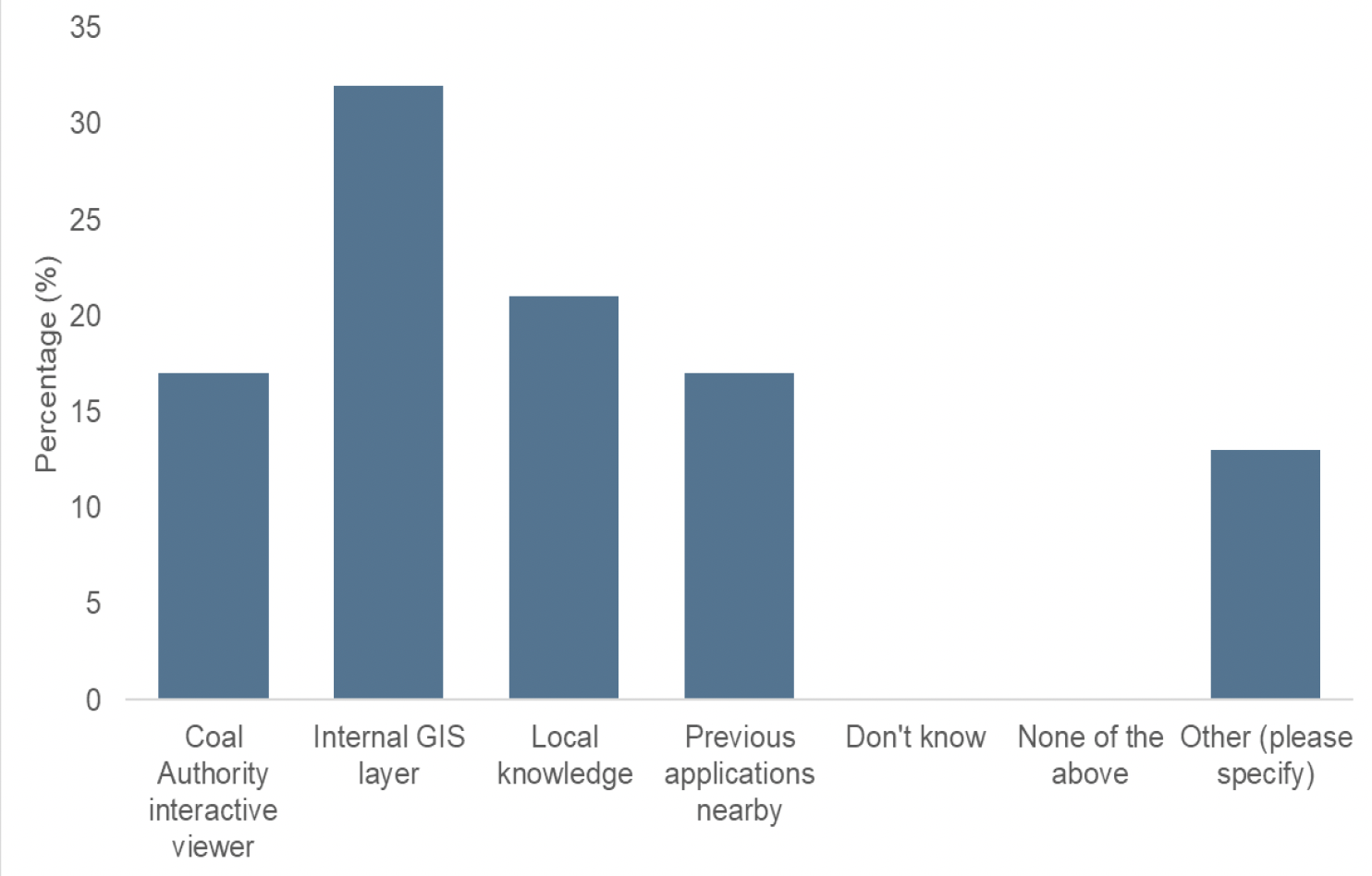
3.13 The dominant method (32% of respondents) was through the use of an internal Geographical Information System (GIS). Other responses included local knowledge (21%) and previous applications nearby (17%). Only 17% of respondents stated they used the CA interactive viewer, which is publicly available albeit at a lower resolution. There were no responses for 'Don't know' or 'None of the above'.
3.14 Of the 13% who provided additional responses under an 'Other' data source to the four options listed, these included historical maps, the contaminated land inspection strategy prepared under Part IIA of the Environmental Protection Act 1990, areas of mineral instability, consultation with colleagues, radon maps and site investigation report(s) submitted by the applicant.
3.15 Participants (all disciplines) were additionally asked in Q9 if they consulted with the CA when the proposed development is in a Development High Risk Area. A Development High Risk Area is defined by the CA as being where coal mining risks are present at shallow depth which are likely to affect new development. High Risk Areas represent 15% of the coalfield areas UK-wide. The CA is a statutory consultee on planning applications for development within the defined coal mining areas of England, Scotland and Wales (CA, 2017). This applies to both Development High Risk and Low Risk Areas.
3.16 Responses are presented in Table 3-3 by respondent department. Only 31% of respondents stated they always consult with the CA and 38% of respondents stated they never consult with the CA. It is noted that there is no requirement for the CA to be consulted as part of the building warrant application process, but the CA is a statutory consultee under planning for coal mining reporting areas. Eight, out of 12, respondents from a Planning department stated they always consulted with the CA. This is likely to be a reflection of planning applications that fall within a Development High Risk Area. Respondents who stated rarely and usually may have limited development within a Development High Risk Area.
Department |
Don't know |
Never |
Rarely |
Sometimes |
Usually |
Always |
Total |
|---|---|---|---|---|---|---|---|
Building Standards |
0 |
10 |
0 |
2 |
0 |
4 |
16 |
Environmental Health / Public Protection |
3 |
5 |
2 |
1 |
1 |
2 |
14 |
Planning |
1 |
0 |
1 |
0 |
2 |
8 |
12 |
Other |
0 |
2 |
1 |
0 |
0 |
0 |
3 |
Total |
4 |
17 |
4 |
3 |
3 |
14 |
45 |
% |
9 |
38 |
9 |
7 |
7 |
31 |
100 |
Interdepartmental relationships – taking the lead, LA frameworks and degree of departmental interaction [Q10, Q11, Q17]
3.17 Participants were initially asked which service (i.e. department or discipline) in their LA has the overall lead on dealing with sites where CO2 mine gas is assessed as likely to be present. A single respondent did not know, which could equally be interpreted as none having an overall lead. The results are presented in Table 3-4.
3.18 An equal 31% of respondents identified Environmental Health (or its equivalent) or all three departments as having the overall lead. This may reflect the breadth of technical knowledge held by the EHO/ CLO role, but also that expertise may be found in each department at those LAs.
3.19 Only two respondents (5%), from different LAs, identified no single overall department taking the lead: One stating 'All of the above' which could equate to 'None' with the other naming a specific department. For both these LAs a differing departmental response was received for this question from the respondents.
3.20 When evaluating individual responses, it was apparent that responses were not consistent across the responding LA. Of the 15 LAs where more than one department responded to the survey, nine answered differently and six agreed regarding the department with the overall lead.
Department with overall lead |
Responses (count) |
Responses (%) |
|---|---|---|
Building Standards |
5 |
11 |
Environmental Health / Public Protection |
14 |
31 |
Planning |
9 |
20 |
All of the above |
14 |
31 |
None |
2 |
4 |
Don't know |
1 |
2 |
Total |
45 |
100 |
3.21 Participants were subsequently asked if their LA had an existing framework (formalised or informal) for regulating the risk of CO2 mine gas on a development site. Forty-nine percent of respondents stated there was an existing framework. Twenty nine percent of respondents stated they did not know if there was or was not. The survey results are presented in Table 3-5.
3.22 When analysing multiple responses from the same LA (i.e. responses from each department at the same LA) it was apparent for 11 LAs that there were conflicting responses regarding if there was an existing framework.
By department |
Don't know |
No |
Yes |
Total |
|---|---|---|---|---|
Building Standards |
4 |
2 |
9 |
15 |
Environmental Health / Public Protection |
3 |
5 |
6 |
14 |
Planning |
4 |
2 |
5 |
11 |
Other |
2 |
1 |
2 |
5 |
Total |
13 |
10 |
22 |
45 |
% of respondents |
29 |
22 |
49 |
100 |
3.23 Participants were additionally asked about their view of the relationship between Planning and Building Standards (see Figure 3-2). Respondents were asked to rank the degree of interaction between the two departments on a scale of 1 (poor) to 10 (excellent). The responses include those from the EHO/ CLO respondents who may have an external view of the relationship between Planning and Building Standards departments (unless sited within them).
3.24 Thirty-four respondents (76%) rated the degree of interaction as a 6 or above, i.e. above average. Of these, seventeen respondents (37%) rated the degree of interaction as a 9 or 10, i.e. excellent. Only two respondents (4%) rated the degree of interaction as 'poor' (a 1 or 2). The remaining 20% of respondents rated the degree of interaction as between 3 and 5, i.e. average.
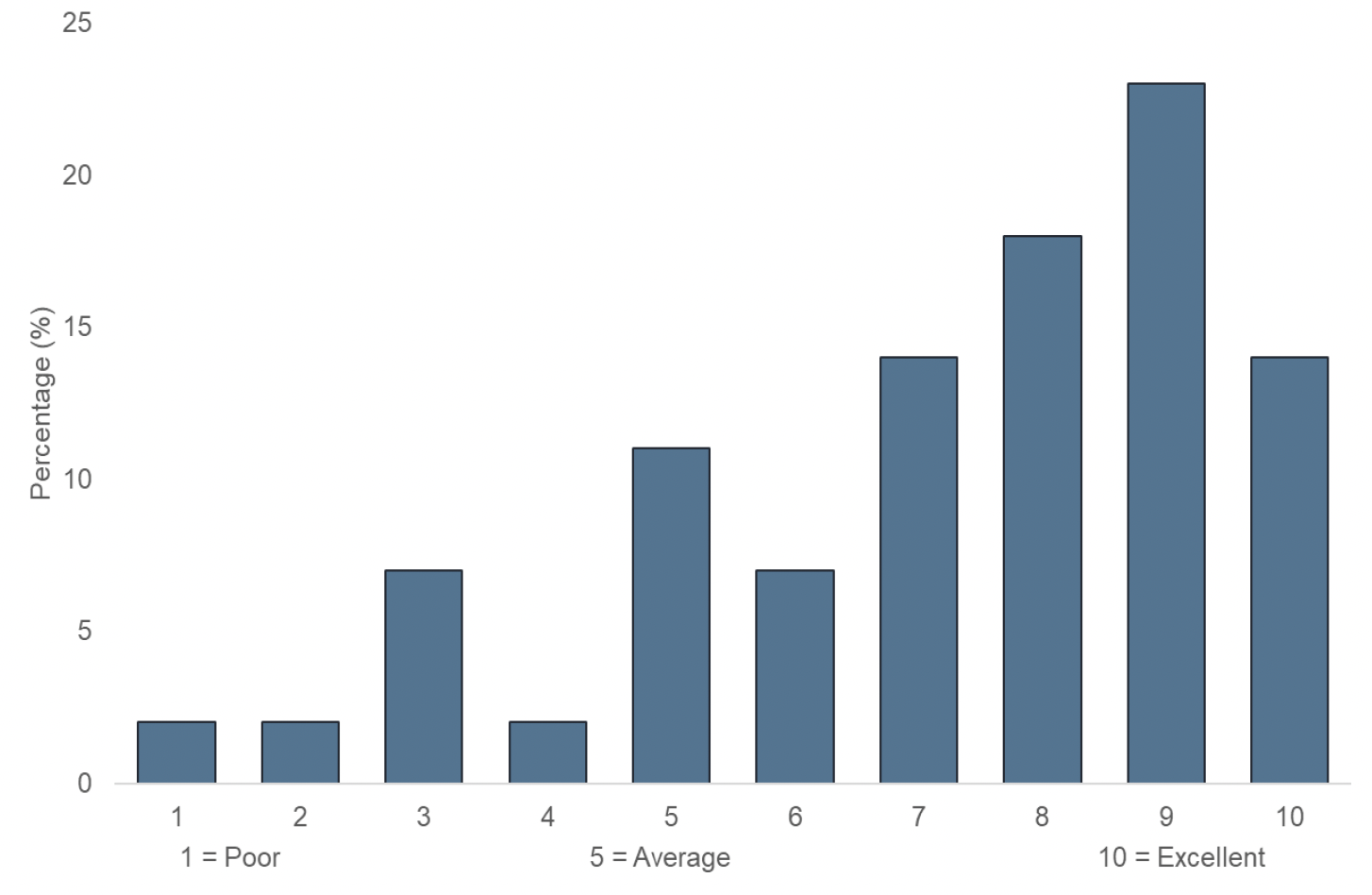
Planning and building warrant conditions, and verification of remedial measures [Q12, Q13, Q14, Q15, Q16]
3.25 Participants were asked four questions relating to the use of 'standard' land contamination planning conditions, building warrant conditions or mine gas 'specific' conditions. The results are presented in Figure 3-3.
3.26 Sixty-nine percent of respondents stated standard planning conditions for land contamination were used at their LA, with only 11% responding 'No' (not used) and 20% as 'Don't know'. Specific mine gas related conditions were stated to be used in planning by 44% of respondents, with 27% responding 'No' (not used) and 29% as 'Don't know'.
3.27 With regard to whether Building Standards have standard conditions on mine gas, the responses were 20% for 'Yes', 44% for 'No' and 36% for 'Don't know'. The equivalent responses for Building Standards including specific conditions on CO2 mine gas were similar at 18%, 44% and 38%, respectively,
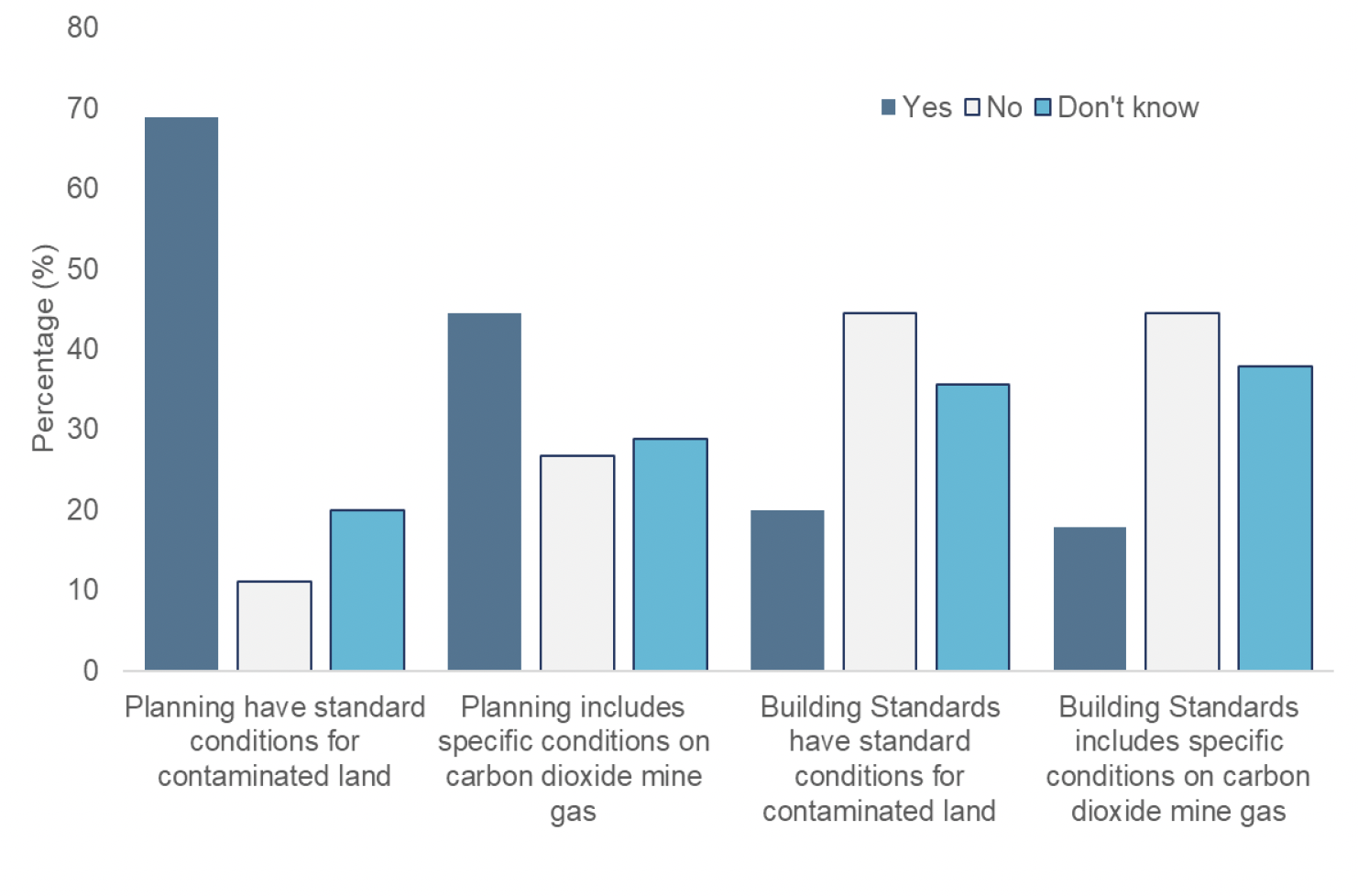
3.28 Following on from the questions relating to the use of standard or specific conditions, participants were asked about verification of remediation for mine gas (Q16), i.e. the incorporation of gas protection measures into development. The majority of respondents (67%) stated they required a verification report prepared by a suitably qualified consultant or installer to be submitted. Three respondents from three different disciplines (6%) stated verification included a site visit with officer assessment in addition to a verification report. Only one of the three respondents was in Building Standards. The three respondents were from three different LAs.
Staff capability [Q18, Q19, Q20]
3.29 Participants were asked two questions about staff capability in relation to mine gas risk assessment and mitigation design report review on a scale of 1 (poor) to 10 (excellent). Here there was a broad range of responses received. It is acknowledged that questions about perceived capability will be subjective. The results for both questions are presented in Figure 3-4.
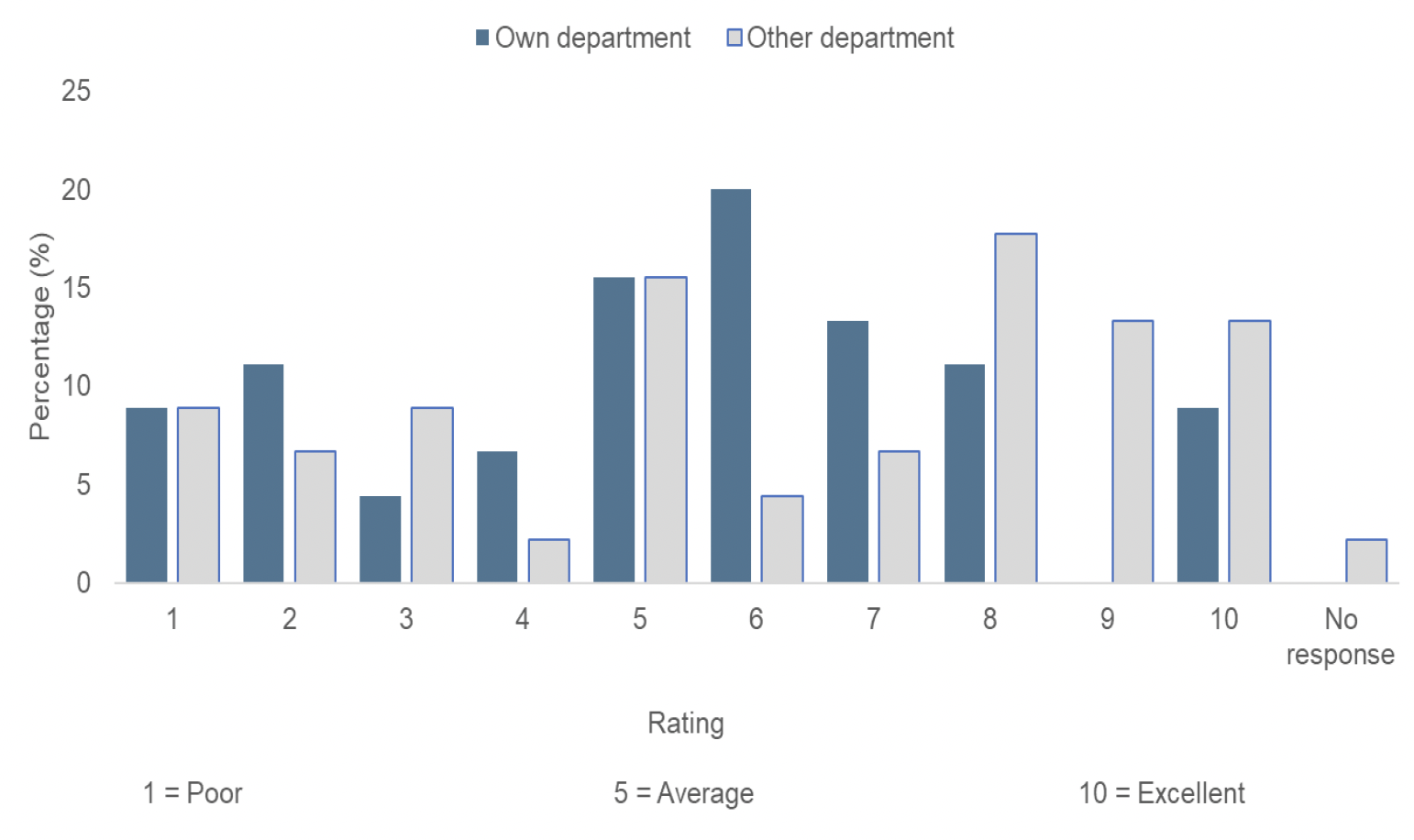
3.30 The first question related to capability within the respondent's own department. Four respondents (9%) rated staff capability within their department as 10 (excellent), and four respondents (9%) rated staff capability within their department as 1 (poor). Forty-seven percent of respondents rated staff capability between 1 and 5 (i.e. poor to average) and 53 percent rated staff capability between 6 and 10 (average to excellent). The majority rated staff capability to broadly be average.
3.31 The second question related to if the capability for undertaking critical review of mine gas risk assessment and mitigation design reports did not sit within their department, what was their perception of staff capability in the other department. Responses to this question may be more subjective than the first question where respondents will have a better understanding of their own departmental capability.
3.32 Six respondents (13%) rated staff capability within another department as 10 (excellent), and four respondents (9%) rated staff capability within another department as 1 (poor). Forty-two percent of respondents rated staff capability in another department between 1 and 5 (i.e. poor to average). Fifty-six percent staff capability in another department between 6 and 10 (average to excellent). One respondent did not submit a response to this question.
External peer review support [Q21, Q22, Q23, Q24]
3.33 Twenty four percent of respondents have engaged external peer review support for critical review of mine gas related reports.
3.34 Of those that have engaged external peer review support, only 11% stated this to be 'always'.
3.35 Sixty two percent had not engaged external support, and 13% did not know whether this had been done. With the exception of four LAs the responses of either yes or no were consistent across all respondents at the same LA. This is suggestive that at those four LAs, some departments may seek external peer review support while others do not, and this is not known by the other department.
3.36 The reasons given for not engaging external support (respondents could tick all that applied) were sufficient capability in-house (23 responses), financial constraints (11 responses), mine gas issues rarely encountered (26 responses) or other (unspecified; 18 responses).
3.37 Responses in relation to the benefit of the external support on a scale of 1 (poor) to 10 (excellent) were fairly evenly split across poor, average and excellent (31, 24 and 20%, respectively).
Publications and guidance [Q25, Q26]
3.38 Participants were asked two questions about relevant publications and guidance that (i) they routinely used themselves and (ii) they refer developers to, in relation to mine gas. Five key documents were presented as options, alongside 'Don't Know' and 'Other'. Participants could tick all that applied. The results are presented in Figure 3-5 with broadly similar responses between the two questions.
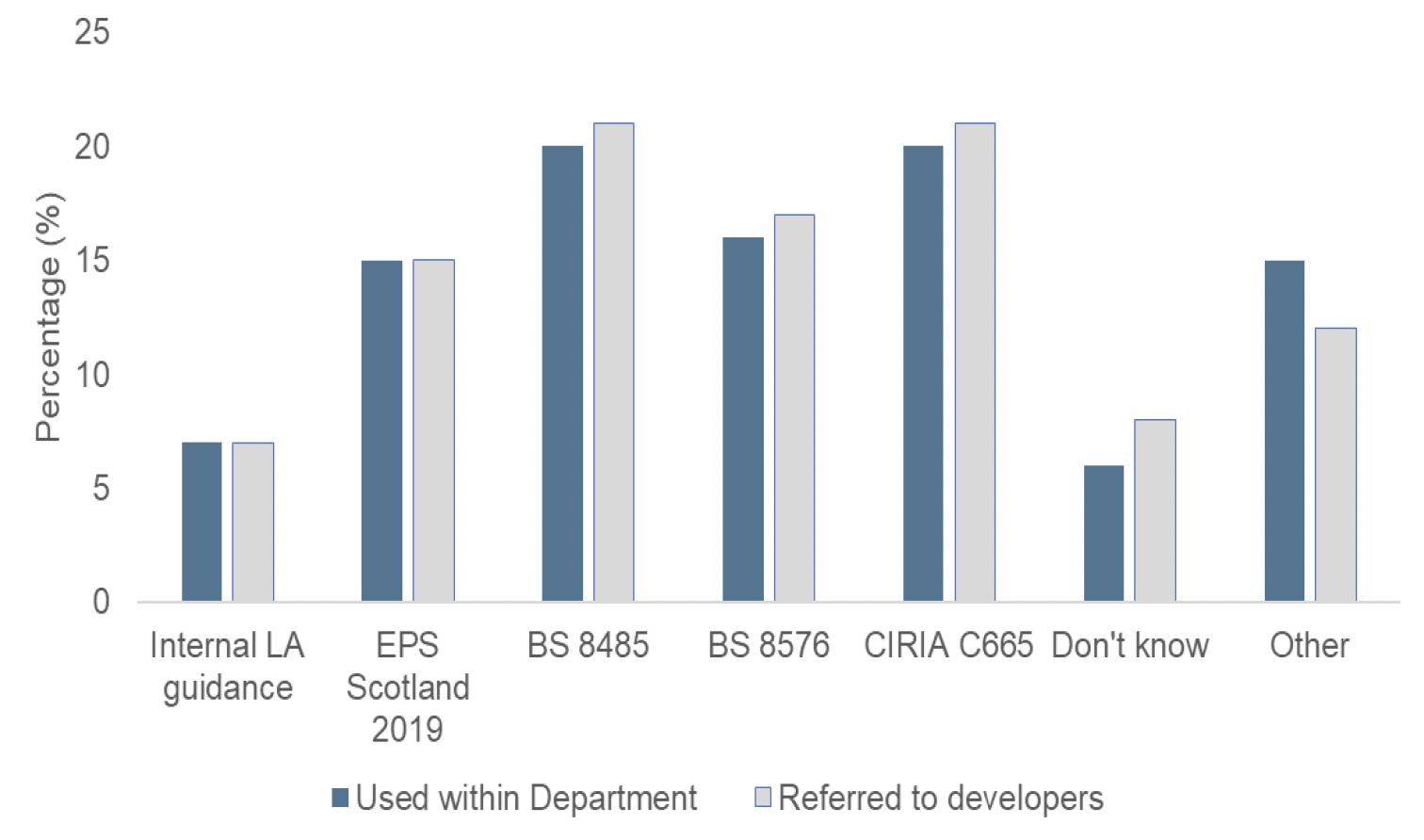
3.39 Here the responses will likely be a reflection of the department a respondent works in and the information developers will require from that department.
3.40 Internal LA guidance was used by only small number (7%) of respondents with the same number stating they had local authority specific supplementary guidance they referred externally to developers. Use within department and developers were referred to the EPS 'Land contamination and development guidance' (EPS, 2019) by 15% respondents each.
3.41 Respondents working in Environmental Health referred internally to the most guidance documents, with selections dominated by BS8576 (BSI, 2013) on investigations for ground gas (16% of responses), BS8485:2015 + A1:2019 (BSI, 2019) ((20% of responses) and CIRIA (2007) C665 for assessing risks posed by hazardous ground gases (20% of responses). When considering BS8485 (BSI, 2019) relating to the design of protective measures, only six Building Standards officers responded that they routinely used this document with five responding that they refer to CIRIA (2007) C665.
3.42 Other documents referred to internally or externally (15 and 12% responses for internal use and referrals, respectively) included Building Standards Technical Handbook by four Building Standards respondents, CIRIA (1995) R151 Interpreting measurements of gas in the ground: methane and associated hazards to construction, CIRIA (2019) C758D Abandoned mine workings manual and CL:AIRE TB17 on ground gas monitoring (Card et al, 2012).
3.43 'Don't know' was selected by 15% of respondents for internal use and 12% for referrals.
Training [Q28]
3.44 Participants were asked if they felt that they needed specific training on mine gas issues to regulate this issue effectively. Seventy eight percent responded yes. One respondent selected not applicable and the remaining 20% expressing no need for training in this area.
Relevant data from LA consultation during previous research project
3.45 Written submissions in relation to the 2019 research project (SG, 2019) were reviewed to supplement the above survey findings. These mainly related to EHO/ CLO staff with one response from a planning department. Key points from this that are relevant to the current study are as follows:
- Changes to legislation may lead to more permitted development where no planning permission is necessary, leading to major delays at building warrant stage. Extensions to properties where the existing property has no remediation in place are also of concern.
- Technical bulletins are required for raising awareness of mine workings issues as well as Guidance / Technical bulletins on best practice for ground gas protection system design specifications (i.e., material specifications, foundation schematics etc) and how to verify their installation.
- Local Authority contaminated land staff are not necessarily qualified to understand foundation design drawings and we often have to work with our colleagues in Building Standards to ensure submitted drawings show the correct details. Builders or their agents often submit drawings that do not conform to the remedial action. We are also only a consultee in the development management process, and we have to ensure our recommended model planning conditions are acceptable from a planning perspective. One of the things we are trying to achieve in Scotland is consistency of regulation between local authorities so that developers can expect similar standards to be accepted irrespective of the location of their proposed site.
- Suitable training courses for practitioners and regulators are required. Training / awareness on ground gas risk and protection should be targeted to contaminated land officers, environmental health officers, building standards officers, planning officers, consultancy assessors and developers.
- As one of a very small number of people in Scotland who has attended the CL:AIRE Membrane Verification course, I am in the uncomfortable position of being unable to accept at face value any verification reporting I have reviewed (visual / photographic inspection is no verification at all). Gas membranes also have to survive the installation process, which means every worker on site needs to understand the importance of their continued integrity. Examples of accidental subsequent penetration of membranes are commonplace.
- A register / list of approved expert consultants would be helpful to all LAs in selecting appropriately qualified expertise at short notice.
- There should be a requirement for Building Standards staff or another body, to undertake spot checks of gas measures as they are going in rather than relying entirely on self-certification. Unfortunately, most Building Standards staff or CLOs are not trained in such matters and so additional resourcing and training would be required to achieve this for LAs. In England I understand that LAs pay NHBC to do this for them however this I do not believe happens in Scotland.
- Verification is risk-based. Where there is no obvious source of gas production such as landfill or shallow mining, or where there is a well-ventilated sub-floor, or where a cast in-situ floor slab has been used, it may be possible to be pragmatic about the risk from ground gas. Responsibility for safe development rests with the developer.
- Something that is rarely done properly is the decommissioning of existing site-investigation boreholes which risks leaving a preferential pathway for ground gas.
- It is easy to fit ground gas protection badly. Good integrity across the whole floor area in average weather conditions on a building site is difficult to achieve, and few installers are suitably trained. Even at the design stage, mistakes are made relating to the specification of gas protection because this is new for many house builders.
Key findings of the survey and commentary
3.46 The key findings from the online survey, relating to the objectives of the research project, are discussed below.
3.47 An excellent response rate was received overall with responses received from all but one of the 23 target LAs. Forty-five individual responses were taken forward with good representation from all three discipline areas.
3.48 An internal GIS is the most common method to identify if the proposed development is in an area with potential mine gas issues. Responses would suggest not all LAs have an internal GIS as only 32% of respondents used these when screening applications for review. Other comments indicated that some LAs request a desk study report to accompany all new build (non-householder) developments. In such cases, reliance is assumed to be placed on the findings of the submitted report. The resources used to screen applications suggested varying levels of understanding, and consistency, in how to identify applications where there may be mine gas risks. This was identified as a possible weakness in processes to be taken forward to the detailed consultation stage.
3.49 The publicly available CA interactive viewer was only consulted by 17% of respondents. Some internal GIS datasets may incorporate this for screening of sites, but this percentage is considered to be low. The CA interactive viewer provides an easily accessible interactive map presenting (amongst others) the boundaries of Development High Risk Areas, mine entries and potential zones of influence, surface mining and past shallow coal mining workings. These, combined with an understanding of ground conditions, are key to understanding if there is a potential need to incorporate mine gas issues during the development process, and hence to 'screen' applications for further consideration of this issue.
3.50 Consultation with the CA by Planning officers was also lower than expected, with only eight out of 12 respondents in this department stating they did always consult when the proposed development is in a Development High Risk Area. This is surprising when the CA is a statutory consultee for planning application in all Development High Risk Areas (CA, 2017). The response rate may reflect the prevalence or otherwise within the LA boundary of Development High Risk Areas.
3.51 The department taking the overall lead varied across LAs but was dominated by Environmental Health if there was an overall lead department. This was in line with expectations that the technical and scientific expertise that would typically sit within that department.
3.52 The majority of respondents (75%) rarely or never employed external peer review support, although 16% 'usually' or 'always' do so. Responses on the value of external peer review varied widely suggesting there is a need to improve the consistency and quality of this, as well as to provide an approved register of suitably qualified and experienced consultants.
3.53 A large proportion of LAs (49%) had an existing framework (formalised or not) when managing the development process when mine gas is a potential issue. However, a significant number of respondents did not know, which could be indicative of the absence of a consistent approach to mine gas issues. The majority of respondents (76%) scored their interdepartmental relationship and degree of interaction as being better than average, which is positive. A good working relationship is likely to lead to a consistent, effective and efficient regulatory approach.
3.54 A large proportion (69%) of respondents stated 'standard' planning conditions for land contamination were used at their authority. This will achieve consistency in ensuring relevant reports are submitted that should incorporate consideration of mine gas risks although the standard wording of planning conditions is likely to vary across LAs. Specific planning conditions relating to mine gas risk are used by some LAs, and this was identified to be explored further in the detailed engagement.
3.55 When verifying remediation, reliance is almost entirely placed on the submission of a verification report complying with BS8485 (BSI, 2019)/ CIRIA (2014) C735. Therefore, the content of that verification report, and the technical capability of those peer reviewing the report content will be fundamental to ensuring appropriate mitigation measures have been implemented at the development. Site visits are not routinely undertaken by any department/discipline when considering all LAs who responded. Only three respondents stated they undertook a site visit, with a single Building Standards officer stating this. Verification of gas protection measures (or lack of) was identified as an area of concern in the 2019 research project (SG, 2019).
3.56 Based on the number of EHO/ CLO respondents (13), and this department typically taking the lead on mine gas related issues, the number of respondents routinely using BS8485 (BSI, 2019) and BS8576 (BSI, 2013) indicates a clear understanding of available guidance.
3.57 The limited use of BS8485 (BSI, 2019) by Building Standards officers could be a reflection of reliance on the technical expertise of the EHO/ CLO when reviewing reports. However, this may be of concern in that the EHO/ CLO's expertise often does not extend to detailed design of gas protection measures.
3.58 The limited use of EPS (2019) contaminated land guidance is surprising, either internally or for referral to developers. However, this may be a reflection of the absence of any reference to mine gas, although the guide does discuss ground / permanent gases. The guidance is intended to help developers, agents, consultants and regulators in their evaluation and management of land contamination. It provides an opportunity for a consistent approach across Scotland, including mine gas impacted areas.
3.59 Training of LA staff on mine gas issues, for effective regulation is considered to be required by the majority of respondents. This is considered likely to be a reflection of the complexity of the area of mine gas risk assessment, or that mine gas issues are encountered infrequently.
Contact
Email: buildingstandards@gov.scot
There is a problem
Thanks for your feedback